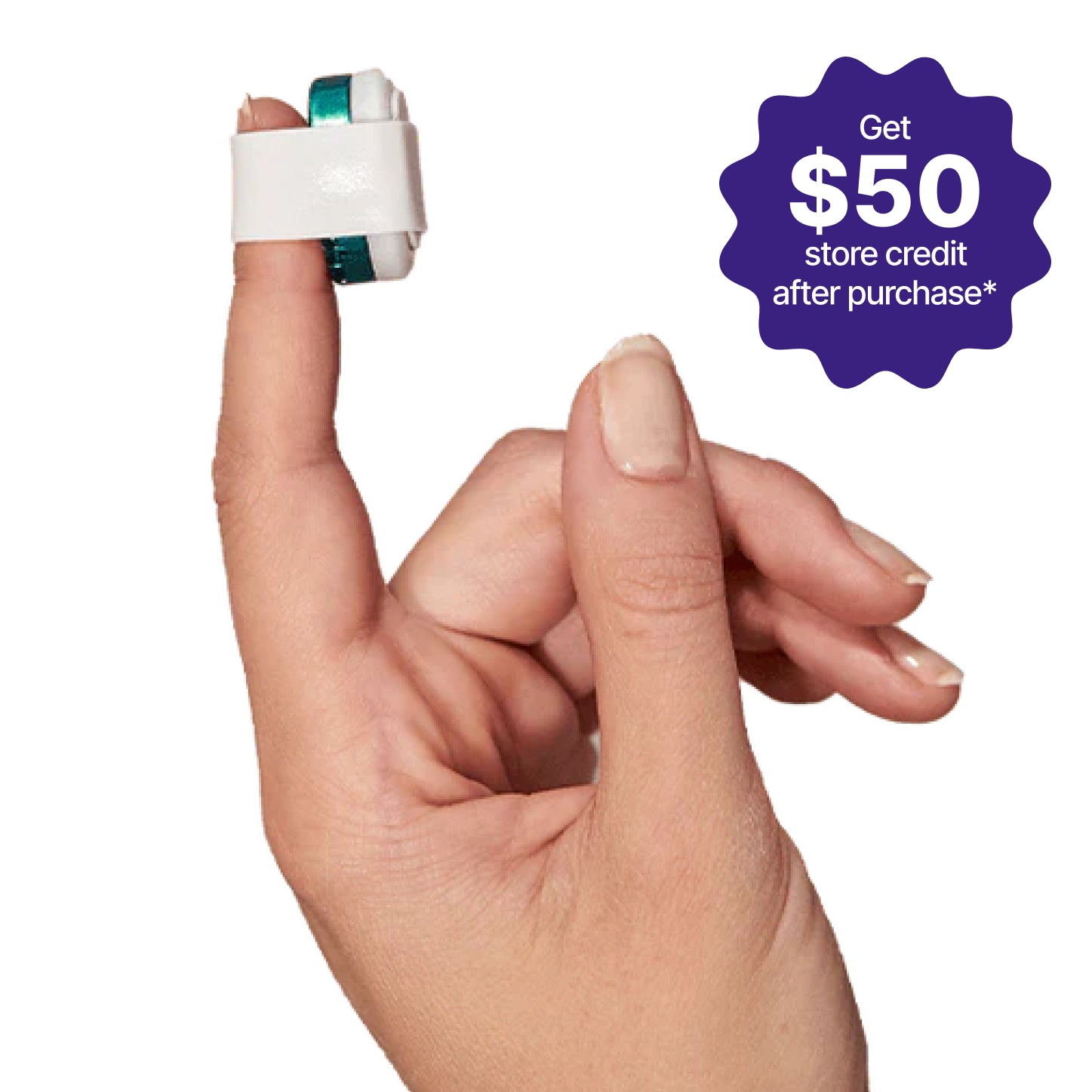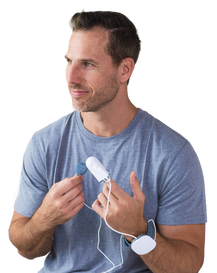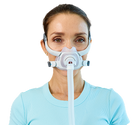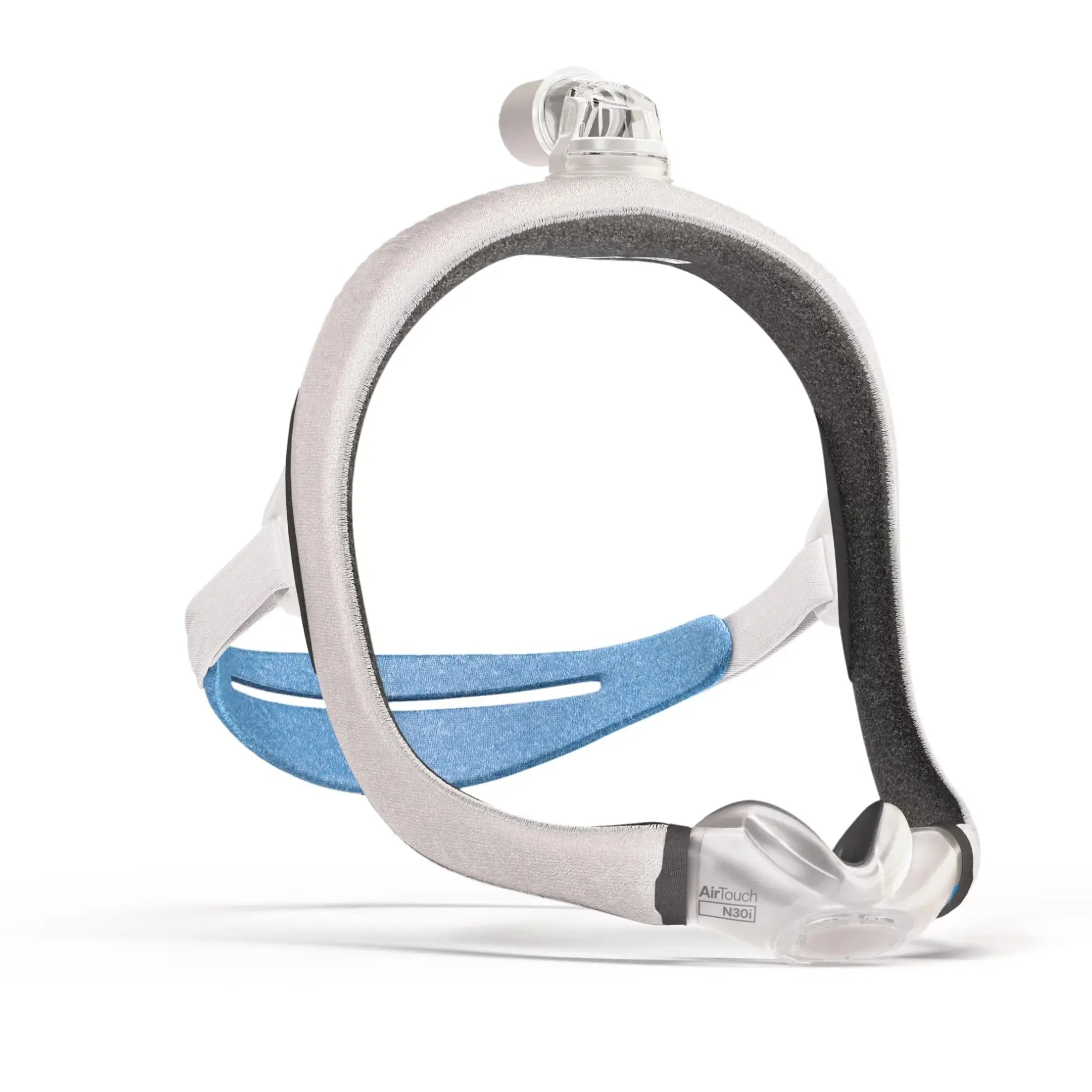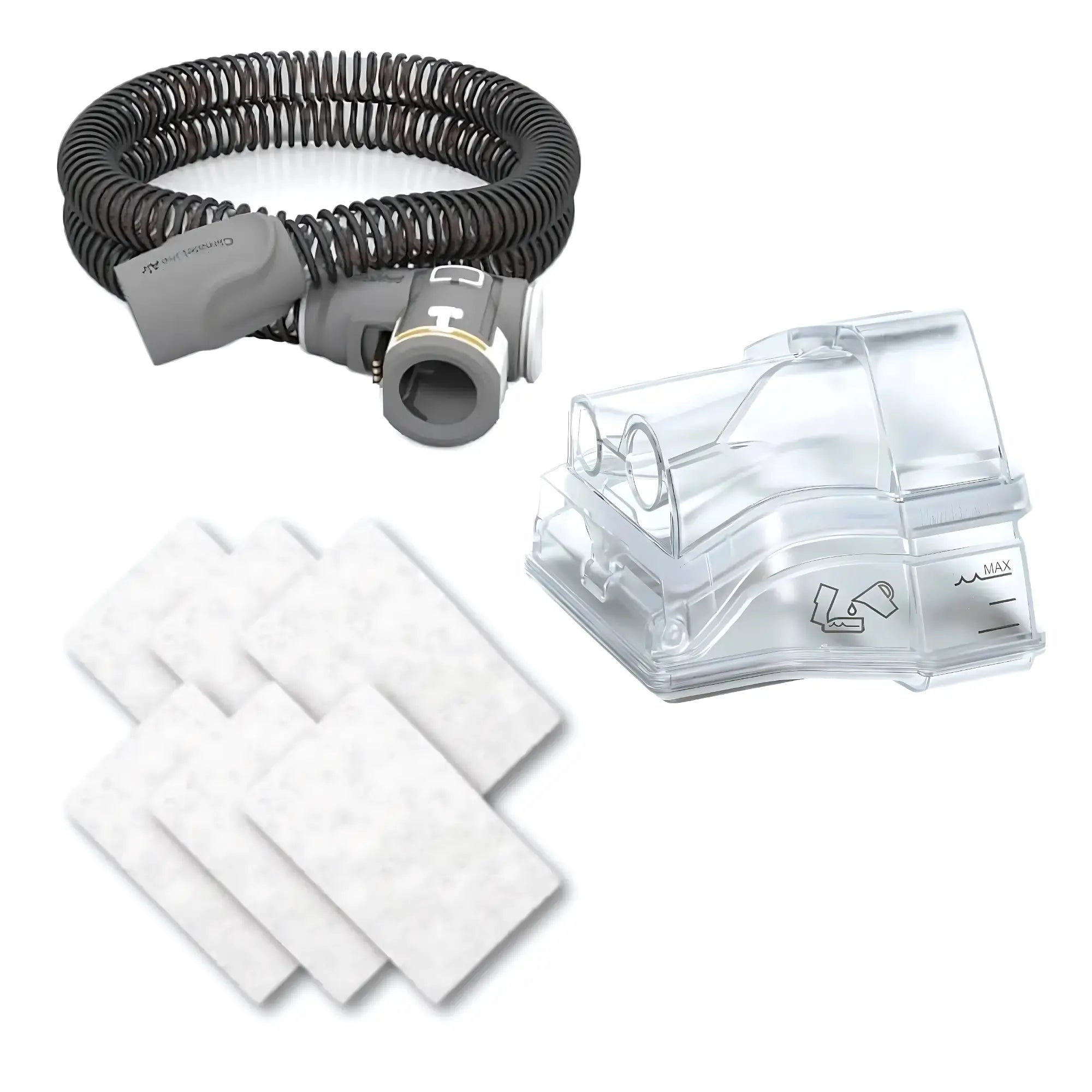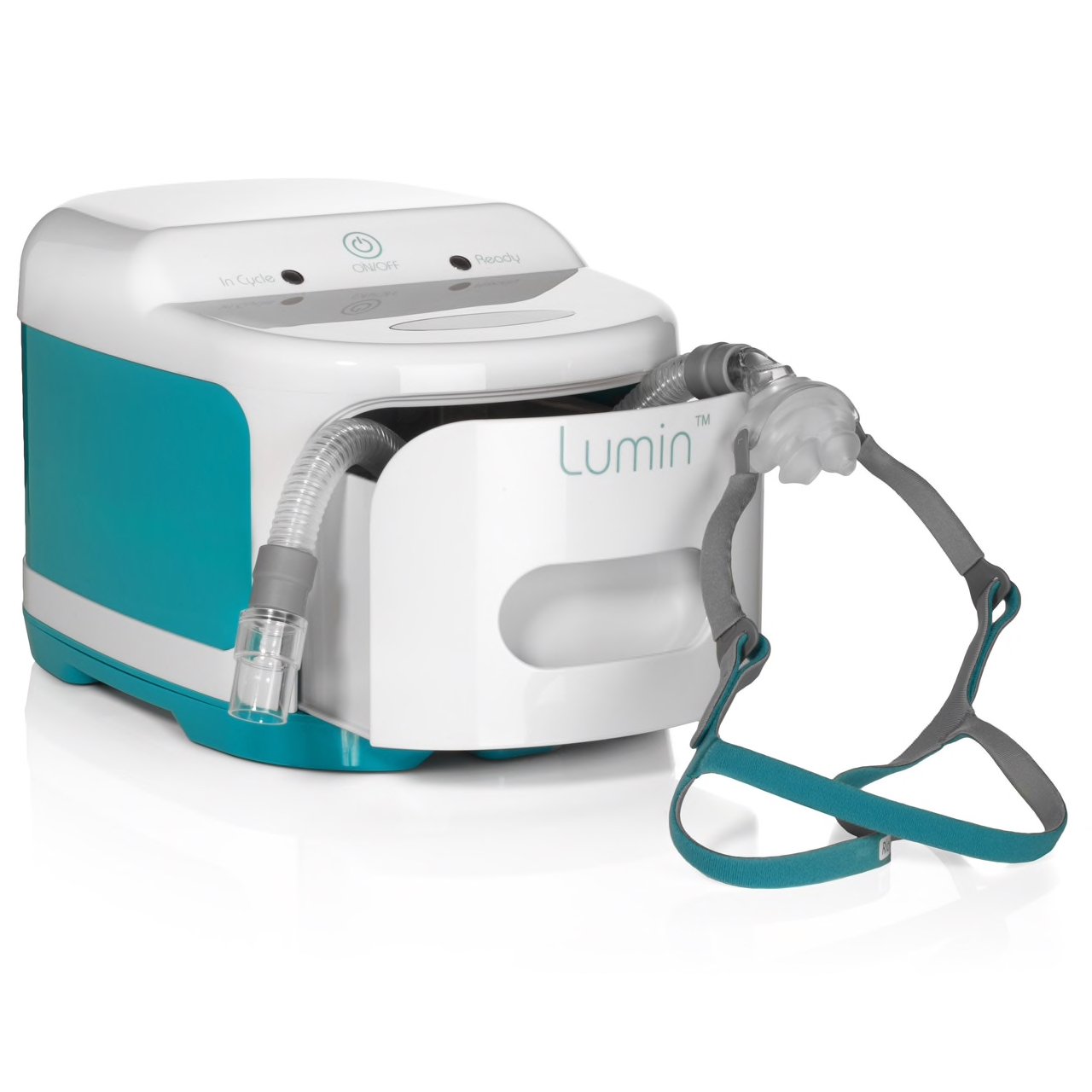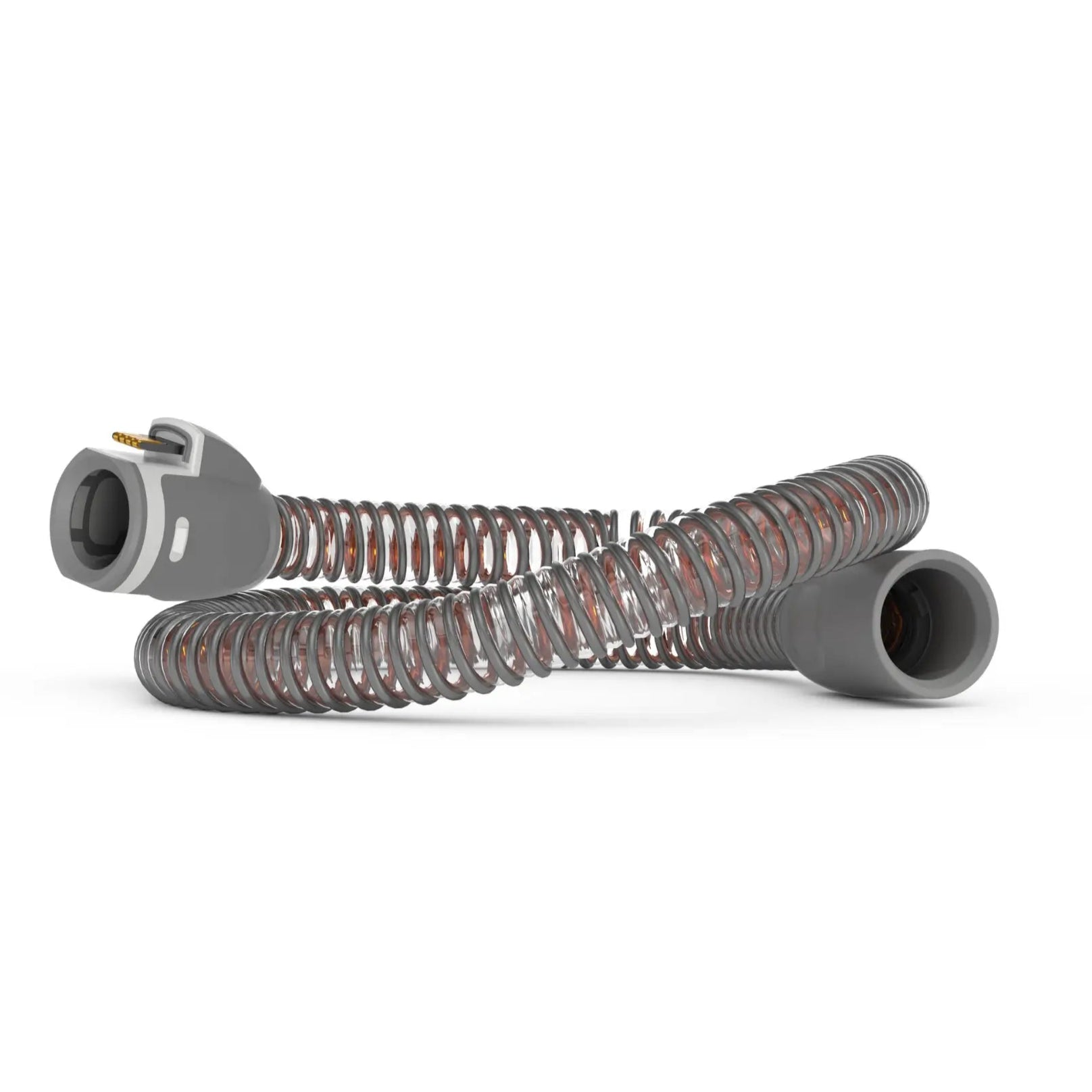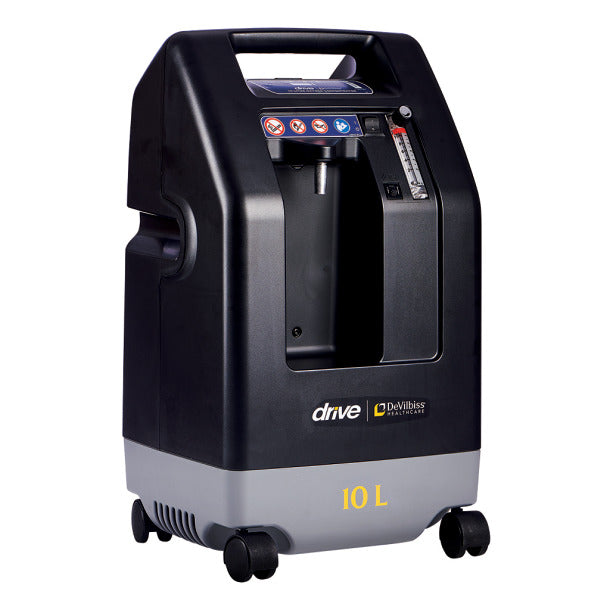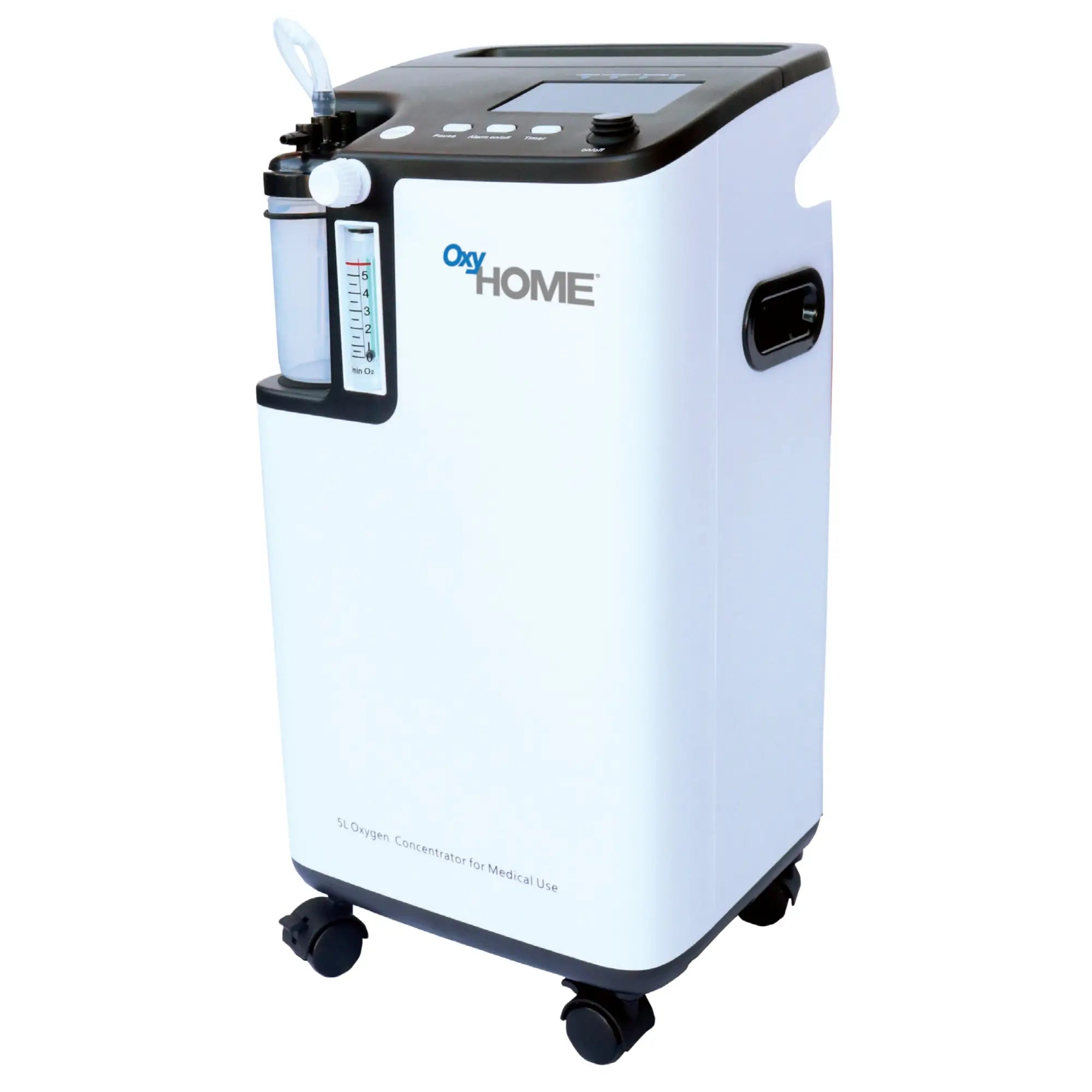
If you're using a CPAP machine, you know how important good CPAP hygiene is. Keeping everything fresh is key; thankfully, CPAP cleaning for your mask and hose is simpler than you might think. It usually just involves soap and water. This regular CPAP maintenance is the best way to go.
However, if you’re looking for extra convenience, a CPAP cleaning machine is highly effective. The FDA advises regarding certain cleaning methods, such as ozone or UV sanitizers, due to potential respiratory and safety risks (Harvard Health Publishing, 2019). [1]
For making daily upkeep easier, CPAP cleaning wipes and brushes are great, and using a pH-balanced option like Snugell CPAP Soap can make your routine gentle yet effective.
What You’ll Learn:
-
How to properly clean your CPAP machine, mask, tubing, and water chamber
-
What products simplify maintenance: Snugell CPAP Soap, CPAP Bubble Pads, and Snugell Tube Brush Set
-
CPAP Cleaning machines for convenient cleaning routines
-
Why cleaning your equipment is crucial to avoid bacteria, mold, and respiratory infections (PubMed, 2025) [2]
-
Expert tips from long-time users on how to stay consistent with a daily routine
Why CPAP Hygiene Matters (More Than You Think)
So, why is diligent CPAP hygiene so crucial?
Consistently cleaning the CPAP machine and its parts isn't just about tidiness; it's fundamental to sanitize the CPAP equipment to prevent the build-up of nasty bacteria and mold. Skipping this essential CPAP maintenance routine can, unfortunately, increase your risk of respiratory infections.
Think about it: your CPAP device, with its warm, moist environment inside the hose and water chamber, can become a perfect breeding ground for things like bacteria, mold, and even yeast or dust mites if not cleaned regularly. Over time, breathing in these particles can lead to respiratory infections, such as bronchitis or sinusitis. In fact, research confirms that "Contamination of CPAP devices is common and has been linked to upper respiratory tract infections in vulnerable patients."
Neglecting your CPAP can have wider implications beyond just infections. A study highlighted in the Annals of Thoracic Medicine showed that poor CPAP maintenance directly impacts therapy adherence and may reduce long-term CPAP effectiveness. [3] It's also worth mentioning that the COVID era brought a heightened awareness of hygiene that led to user misconceptions about CPAP cleaning. Some folks, in an effort to be extra careful, turned to over-sanitization using harmful, unapproved cleaning methods. [4]
On a different note, misunderstanding proper CPAP hygiene can unfortunately lead some users to avoid cleaning altogether out of uncertainty or, worse, use dangerous products like bleach or ozone cleaners. [5]
However, the good news is that maintaining good CPAP hygiene doesn't have to be complicated or lead to the use of risky methods. For quick, daily wipe-downs of your mask, Snugell CPAP Wipes are super handy. For the surfaces of your machine, a product like Snugell CPAP Disinfectant Spray can offer peace of mind. And when it's time for that regular, thorough mask cleaning, a gentle, pH-balanced option like Snugell CPAP Soap is all you need.
11 Proven Tips to Clean Your CPAP Equipment
Let's get into the nitty-gritty of keeping your CPAP gear in top shape.
Properly cleaning your CPAP equipment isn't just a chore; it’s a super important habit that helps extend the life of your device. Cleaning significantly reduces bacteria and other unwelcome guests, prevents potential illness, and ensures your sleep therapy is as effective as possible.
Here are 11 proven tips to guide you.
1. Clean Your CPAP Mask Daily with Gentle Soap
Your CPAP mask is in direct contact with your skin and breath, so daily attention is key for good CPAP mask hygiene. Gently wash your mask (cushion, frame, and headgear if it's washable – check the instructions!) every day using warm, drinking-quality water and a mild, fragrance-free soap. Something like Snugell CPAP Soap is a great choice, or you could use CPAP Bubble Pads for a quick and effective clean. This simple step in cleaning CPAP mask parts thoroughly helps prevent skin irritation and the buildup of oils and germs.
Popular Soaps
2. Wash and Air-Dry Your Tubing Weekly
Your CPAP hose also needs regular TLC, ideally a weekly wash. Fill it with warm, soapy water (using a gentle soap), swish it around, and rinse thoroughly. To disinfect the CPAP tube effectively and tackle any CPAP hose bacteria, a specialized brush like the Snugell Tube Cleaning Brush or a Purdoux Hose Brush can be a game-changer. Ensure it air dries completely by hanging it over a shower rod or a towel rack, away from direct sunlight. Doing so will eliminate any CPAP moisture risk, as leftover dampness is an invitation for germs.

3. Disinfect Your CPAP Humidifier Chamber Regularly
Proper CPAP water chamber care is essential to prevent humidifier mold and other microbes. Empty and rinse your humidifier chamber daily with warm water and mild soap, then let it air dry away from direct sunlight. Once a week, it’s a good idea to sanitize CPAP reservoir more thoroughly. You can do this by soaking it in a solution of one part white vinegar to three parts water for about 30 minutes, then rinsing completely with distilled water and air drying.
4. Avoid Using Tap Water in Your Humidifier
Always opt for distilled water for CPAP cleaning, especially in your humidifier chamber. Tap water contains minerals and impurities that can lead to CPAP mineral deposits inside the chamber. Over time, this buildup can cause tap water CPAP damage to your machine, may encourage bacterial growth, and can even lead to inhaling those mineral particles. Sticking to distilled water keeps your chamber cleaner and your machine happier.

5. Replace Your CPAP Filters Regularly
Proper CPAP air filter maintenance is vital. Your CPAP machine's filters are your first line of defense against dust, pollen, and other airborne particles, ensuring clean air for your therapy.
Most machines use disposable fine filters, and some might also have a reusable foam filter. Disposable ones usually need a filter replacement CPAP routine every 2-4 weeks, or sooner if they look dirty or you're in a dustier environment.
Reusable filters can often be washed weekly with warm water (let them dry completely!), but always check your machine's manual for specific instructions. Letting filters get too dirty can lead to bacteria in dirty CPAP components and reduce your machine's efficiency. You can usually find replacement filters in a comprehensive CPAP Cleaning Collection.
6. Use Cleaning Tablets for Deep Sanitizing
For those times you want to ensure an extra deep clean CPAP session and effectively remove CPAP residue, opt for the CPAP sanitizing tablets. They can be a helpful addition to your routine, though they don't replace manual washing with soap and water. Products like Snugell Tablets or CPAPhero Tabs are designed for this purpose.
Regular cleaning with soap and water is the cornerstone for safe CPAP use, and thorough sanitization practices also contribute to better respiratory outcomes. Always follow the tablet manufacturer’s instructions carefully and rinse thoroughly.

7. Use Wipes for Quick Daily Maintenance
Life gets busy, and sometimes a full wash isn't immediately possible. That's where a CPAP daily wipe comes in handy for quick CPAP cleaning. Specially formulated CPAP wipes, like Snugell Jumbo Wipes, are perfect for wiping down your mask cushion each morning to remove oils, skin cells, and potential CPAP mask bacteria. They're also great for travel when you don't have easy access to a sink. Remember, wipes are for maintenance between full cleanings, not a complete replacement for regular, thorough washing.

8. Sanitize the Outside with Disinfectant Spray
Don't forget the outside of your CPAP machine and the area around it! Good CPAP surface hygiene includes wiping down the device's exterior.
A disinfectant spray formulated for CPAP use, like Snugell CPAP Disinfectant Spray, can be used. Apply the spray in your CPAP frame cleaning and to sanitize CPAP gear, including hard-to-reach spots on the machine's casing. Also, give your bedside table where the CPAP sits a regular wipe-down to reduce dust and germs in its immediate environment.

9. Use CPAP Cleaning Devices for Added Convenience
CPAP cleaning machines add an extra layer of convenience to your CPAP cleaning routine, saving you time and effort. They usually fit more than one piece of equipment at a time and also serve to clean other products like phones and electronics, which also accumulate bacteria.
Popular CPAP Cleaning Devices<
10. Make Cleaning Part of Your Weekly Routine
The key to successful CPAP hygiene is consistency. Creating a CPAP cleaning schedule will make it a manageable part of your life. For example:
-
Daily: Wipe mask cushion, empty/rinse/air-dry humidifier chamber (refill with fresh distilled water before bed).
-
Weekly: Thoroughly wash mask (including headgear if applicable), tubing, and humidifier chamber.
-
Monthly: Clean machine exterior, wash reusable filters (if any), check disposable filters and replace if needed.
To help you stick to your routine for CPAP sanitation, try setting reminders on your phone, using a checklist, or getting a dedicated storage bin to organize CPAP cleaning supplies. Making it a habit is half the battle!
11. Replace Worn-Out Accessories on Schedule
Even with diligent cleaning, CPAP accessories don't last forever. Over time, materials can degrade, making them harder to clean effectively and increasing the hygiene risk that old CPAP gear poses.
Worn-out cushions might not seal well, and old tubing can harbor microbes. Follow the recommended CPAP parts lifecycle: replace CPAP mask cushions and pillows typically every 1-3 months, masks every 6 months, tubing every 3-6 months, and filters as discussed. Staying on top of replacements is crucial for both hygiene and therapy effectiveness.
You can usually find a full range of replacement parts on dedicated CPAP supplier pages, and often your insurance will cover scheduled replacements.
What Not to Use When Cleaning Your CPAP (Warnings)
Knowing how not to clean CPAP gear is just as important as knowing how to clean it. Being mindful of CPAP soap ingredients and other cleaning agents is key.
Using harmful chemicals will mean cleaning your CPAP incorrectly, and can actually harm your equipment, shorten its life, or even be bad for your health. Stick to gentle methods and avoid harsh chemicals, abrasive materials, and heat-based methods that aren't recommended by manufacturers.
Here’s a list of things you should definitely keep away from your CPAP supplies:
-
Bleach or Ammonia-Based Cleaners: These are a definite no-go. The bleach CPAP danger is real, as these harsh cleaners can cause chemical damage to the CPAP. The soft materials in your mask and tubing will break down, and the fumes left behind can be harmful to breathe in.
-
Alcohol or Alcohol-Based Wipes: While alcohol CPAP wipes might seem like a quick disinfectant, they can dry out and degrade your mask's silicone cushion and tubing over time. This can lead to a dry mask cushion and mask cushion damage like cracks, and frustrating seal issues.
-
Scented Soaps, Moisturizing Soaps, or Essential Oils: Avoid soaps with added fragrances, dyes, or moisturizers, and definitely don't add essential oils to your cleaning water. These can leave behind a residue mask component that may cause CPAP irritation to your skin or airways and can even affect the integrity of your mask seal. Always use fragrance-free CPAP cleaner options or a very mild, unscented soap, as generally recommended by equipment manufacturers.
-
Dishwashers: Putting your CPAP machine in the dishwasher CPAP machine might seem like an easy fix, but the high heat and harsh detergent used in most dishwashers can melt CPAP parts or warp them. This can lead to significant CPAP damage cleaning this way, so it's best to stick to handwashing.
-
Very Hot Water (over 104°F or 40°C): While warm water is good for cleaning, excessively hot water can cause heat damage and CPAP deformation. It can also distort the silicone in your mask, leading to a mask cushion deformation situation, and compromise the structure of both your mask and tubing.
-
Abrasive Brushes, Sponges, or Paper Towels: Avoid abrasive CPAP cleaning tools like stiff brushes, steel wool, or rough scouring sponges. Even some paper towels can be surprisingly scratchy. These can cause CPAP scratches on the smooth surfaces and the cushion. This will reduce their integrity, cause mask cushion damage, and create tiny crevices, resulting in bacterial growth in CPAP cases.
When in doubt, refer to your CPAP device's and mask manufacturer's official cleaning guidelines for the most accurate information on caring for your specific equipment.
Common Mistakes to Avoid
Many CPAP users unknowingly shorten the lifespan of their equipment or compromise hygiene by following bad habits. From inconsistent cleaning routines to poor drying practices, here are the most common CPAP cleaning mistakes to avoid, which should help you figure out if you're accidentally doing something that could affect your therapy or gear.
-
Skipping or inconsistent cleaning, especially for your mask: Not keeping up with daily cleaning CPAP routines for your mask is a big one. Skin oils, dead cells, and bacteria in CPAP can build up fast, leading to skin irritation, unpleasant odors, and even affecting your mask seal. To clean the CPAP machine correctly and its accessories, consistency is key.
-
Not letting everything air dry completely: Properly drying CPAP tubing and your humidifier chamber is crucial. If you put them back together while still damp, you're creating a perfect environment for a mold CPAP hose situation or mildew. Ensure everything is bone dry before reassembling to avoid humidity issues and CPAP damage.
-
Using harsh or unsuitable cleaning products: Grabbing standard dish soap (especially scented or with harsh degreasers) or general disinfecting wipes is a common misstep when figuring out how to clean a CPAP mask properly. These can degrade the silicone, leave behind residues that are harmful to breathe, or simply not be effective in sanitizing CPAP parts. Always stick to a mild, CPAP soap or cleaners specifically designed for medical equipment.
-
Forgetting the nooks and crannies: It's easy to focus on the main parts, but hidden CPAP parts like elbow swivels, small mask connectors, or the inside of headgear clips also need attention in your CPAP cleaning routine. Gunk can build up in these spots, too, so give them a good once-over during your regular cleaning.
-
Stretching the life of disposable supplies too long: Even with diligent mask cushion cleaning and overall good CPAP supplies hygiene, parts like cushions, masks, and filters wear out. Trying to make them last longer than recommended can compromise your seal, comfort, and therapy effectiveness. Remember to replace CPAP parts according to the suggested schedule.
-
Overtightening your mask to fix leaks: If you're experiencing a mask leak, your first instinct might be to yank the straps tighter. Often, though, seal issues CPAP users have are due to a dirty or worn-out cushion. In some cases, it could be due to an incorrectly sized mask. Overtightening just leads to discomfort, pressure sores, or those dreaded strap marks without solving the root cause. Clean or replace the cushion first!
CPAP Cleaning Products You Can Trust
When it comes to keeping your CPAP gear pristine, choose trustworthy CPAP cleaning products specifically designed for medical equipment. These specialized CPAP cleaning supplies help you avoid damaging your gear. They also support safe and effective therapy, and can actually make your CPAP equipment care routine much easier than if you were using generic soaps or harsh chemicals.
Here are some categories of trusted products that can help you maintain excellent CPAP hygiene:
1. CPAP Mask Wipes
These are fantastic for quick, daily wipe-downs of your mask cushion, especially right after you wake up to remove any oils or saliva. Using unscented wipes like the Snugell Jumbo Pack CPAP Mask Wipes, often considered among the best CPAP mask cleaner options for quick touch-ups, helps prevent residue buildup and can extend the life of your mask. You can browse a variety of such wipes in the CPAP Cleaning Wipes Collection.
2. CPAP Soaps & Bubble Pads
For a more thorough daily or weekly wash of your mask and other parts, a gentle, fragrance-free soap is essential for proper CPAP accessories care. These soaps, such as Snugell CPAP Soap, are formulated to effectively remove skin oils and buildup without degrading the silicone or plastic. Bubble Pads CPAP Soap Packets are also a great option for convenient, pre-measured portions, perfect for travel or simplifying your routine.
3. Hose Brushes & Cleaning Tools
Getting the inside of your long CPAP hose truly clean can be tricky, but it's vital for preventing mold or debris. Specialized CPAP hose cleaner tools, like the flexible Snugell CPAP Brush Set or the Purdoux CPAP Hose Brush Set, are designed to reach all the way through your tubing and clean out any lurking residue.
4. Cleaning Sprays & Disinfectants
A specially formulated spray can be handy for sanitizing the external surfaces of your CPAP machine or other non-silicone parts to achieve a safe CPAP sanitizer effect on external surfaces. Look for options like Snugell CPAP Disinfectant Spray, which is designed to neutralize germs without the harsh chemicals that could damage your equipment or irritate your airways.
5. Mask Cleaning Tablets
If you're looking for an efficient way to give your mask, cushion, or humidifier chamber a deep clean, cleaning tablets can be a good choice for occasional use. Products like CPAPHero CPAP Mask Cleaning Tablets or Snugell CPAP Mask Cleaning Tablets dissolve in water to help break down residue and sanitize your equipment. Just remember they complement but don't fully replace; regular manual washing is needed to remove all physical debris.
6. Automated Sanitizing Devices
For those seeking added convenience in their CPAP hygiene routine, particularly for travel or as a supplemental step, some automated sanitizing devices are available. Options like the NuWave CPAP Cleaner (Travel), the Cspring RediClean CPAP & BiPAP Cleaner, or the Liviliti Paptizer UVC LED Sanitizer aim to make this process quicker.
As with any cleaning method, it's important to understand how these devices work and use them according to the manufacturer's guidelines. This is typically done alongside regular manual cleaning to ensure all physical residues are removed.
FAQs
What’s the safest way to clean a CPAP machine?
Handwash your mask, tubing, and humidifier with mild, fragrance-free soap and warm water. That's safest for components. Just wipe down the machine's exterior with a damp cloth. Avoid harsh chemicals, bleach, and never soak the main unit!
Can a dirty CPAP machine make you sick?
Yes, a dirty CPAP can make you sick. When inhaled, uncleaned gear breeds bacteria, mold, and viruses, which can cause respiratory infections, sinus issues, or allergies. Regular cleaning is crucial for your health.
Are CPAP cleaning machines worth it?
Automated CPAP cleaners (ozone/UV) offer convenience but aren't FDA-approved as a substitute for manual cleaning, which removes debris. They also don't clean away oils or mucus, so you'll still need to wash parts. Weigh their convenience and cost against official guidelines, as soap and water cleaning is still the gold standard.
How often should I clean my CPAP hose or mask?
Clean your CPAP mask daily, especially the cushion, to remove skin oils and germs from direct contact. Your CPAP hose should be washed thoroughly once a week to keep it fresh and prevent internal buildup.
What can I use to disinfect my CPAP?
Use mild, CPAP-friendly soap and warm water to regularly clean and disinfect your mask, hose, and humidifier. For a deeper clean, soak the humidifier chamber in a 1:3 vinegar-water solution for 30 minutes, then rinse well. CPAP-specific sprays can be used on the machine's exterior; avoid bleach or alcohol on components.
Does vinegar kill mold in CPAP tubing?
Yes, a diluted vinegar solution (1 part vinegar to 3 parts water) can help kill mold in CPAP tubing for occasional deep cleaning. However, prevention is key: wash your hose weekly with soap and water, dry it completely, and consider using a tube brush to dislodge buildup.
What parts of a CPAP need daily vs weekly cleaning?
Daily: Clean your mask cushion (and frame if oily) and replace humidifier water (empty, rinse, refill with distilled). Weekly: Thoroughly wash the complete mask system (including headgear if washable), tubing, and humidifier chamber with soap and water. Check/clean/replace filters monthly or as needed.
References
-
Harvard Health Publishing. “Can Your CPAP Make You Sick?” Harvard Health Blog, 8 Oct.2019, health.harvard.edu
-
Mando N, Antonious D, Gillen N, Joseph M, Thomson E. Pseudomonas Unmasked: Poor Continuous Positive Airway Pressure (CPAP) Hygiene Leads to a Case of Pseudomonas Pneumonia. Cureus. 2025 Jan 20;17(1):e77697. doi: 10.7759/cureus.77697. PMC
-
American Academy of Sleep Medicine. “FDA questions safety of CPAP cleaning devices using ozone or ultraviolet light,” AASM, 28 Feb. 2020
-
ResMed. “How to Clean CPAP Equipment.” ResMed, Accessed 4 June 2025.
-
Patel SR. Providing Cleaning Recommendations for Positive Airway Pressure Devices. Ann Am Thorac Soc. 2024 Jan;21(1):27-29. doi: 10.1513/AnnalsATS.202308-683VP. PMC
- U.S. Food and Drug Administration. “Do You Need a Device That Claims to Clean a CPAP Machine?” FDA, 8 Aug. 2024



